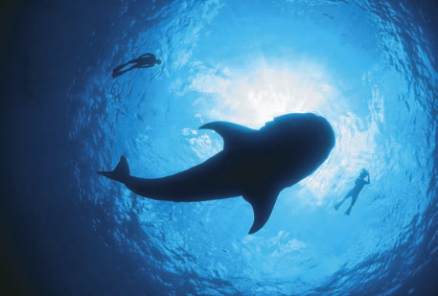Basic HTML Version












66
|
SUMMER 2012
As I gazed from the tuna tower, a sparkle on the horizon
caught my attention. Training my eyes on the spot, I saw
what appeared to be a disturbance on the surface about a
mile from our boat. Excited, I shouted down to Captain
Rogelio for confirmation. “No, just bonito,” came his
reply. We continued the search, and 10 minutes later that
disturbance was still in the same position. Bonito move fast
and savage their prey in minutes, so I knew something else
was out there. Closer investigation was needed, and with
guarded excitement we set an intercept course.
All eyes fixed on the horizon as a hush fell over our team.
Six months of anticipation had led up to this expedition
— one that
depended solely
on our captain’s
intuition and
our best guess
at timing. A
dozen miles
off the coast of
Mexico’s Isla Mujeres, we had been searching these empty
seas for hours and had not found anything. But that changed
in an instant as a large fin suddenly appeared and cut across
the surface only 50 yards from our boat. Beyond it more fins
Isla Mujeres:
Reflections of the Past
TEXT AND PHOTOS BY SHAWN HE INRICHS
come from below and drive the sardines up toward the
surface. The regiment of sailfish vigilantly guards the
perimeter to maintain the tightly packed sardine ball. Other
sailfish swim below to prevent the sardines from making
a dash back to the safety of the large shoal below. What
follows next is one of the most exhilarating displays of
cooperative hunting found anywhere.
The sardines know they are trapped and make a frantic
dash to escape. In unison, the sailfish guarding the perimeter
throw up their sails to block the approaching ball. Thwarted,
the ball glances off and dives down toward waiting sailfish
that set upon them with a fury, ripping through the ball with
sharp, thrashing bills. Scales shower down as the sardines
frantically race back toward the surface. The sailfish now
have the advantage, and with the ball under control the hunt
begins in earnest.
Moments before it strikes, a sailfish hoists its sail while
flashing brilliant colors down the length of its body. This
display may be a prestrike warning to the other sailfish, or
it’s meant to distract the prey. An instant later the sailfish
launches upward, racing into the wall of baitfish and
swatting the silvery fish with its deadly sharp bill. Scales fly,
and injured sardines break from the safety of the ball. Before
they realize their mistake, the sardines are snatched up into
the mouths of the ravenous sailfish.
The surface presents other hazards to the ill-fated
sardines. Hungry frigate birds swoop in and snatch at the
baitfish as they pop to the surface. Pelicans join the action,
plunging in and scooping up mouthfuls of the fish. The
assault continues, and hapless sardines are ripped apart
from above, below and all sides. One by one, exhausted and
injured, the baitfish fall to the sharp bills of the sailfish.
BEING THE BAITBALL
The battle between sailfish and sardines plays out again and
again as bands of sailfish savage the weary baitfish. When
humans enter the equation, however, the dynamic shifts
of the hunt are all too often disrupted. Through trial, error
and countless hours in the water with these animals, I have
learned some important lessons about how to get close to
the action without disrupting it.
The chase.
Chasing marine life is generally frowned upon, as
it disturbs the animals and results in suboptimal encounters.
But with sailfish you have no choice; the baitball is
constantly on the run, with the school of sailfish in relentless
pursuit. When you first drop in, the sailfish appear to view
you as a competitor, and both predators and prey run from
you. Excellent fitness and bullheaded resolve are essential to
swimming down the ball until your presence is accepted.
See the light.
The sardines constantly run toward the sunlight
because it obscures their profiles from the predators, and
having the sun at your back is desirable if you’re taking photos.
If you constantly maneuver into position between the sunlight
and the sardines, then eventually both predators and prey will
yield to your presence, and the frantic chase will slow into a
methodical hunt.
Breathing room.
With the action contained, the baitfish
will often seek shelter under you as protection from the
sailfish. Unfortunately this will work, killing the predation
and causing the sailfish to retreat. It is critical to back off
and give the predators room to strike without interference.
Rotating in and out of the action ensures you will achieve
extended baitball encounters and capture epic images.
To personally experience the power and intensity of a
sailfish baitball is to witness one of greatest struggles for
survival in nature. Each winter squadrons of sailfish do battle
in the waters surrounding Isla Mujeres. Long days with
hours of searching are a prerequisite for finding the action.
But persistence and hard work will pay off, and you, too, can
become one with the baitball.

